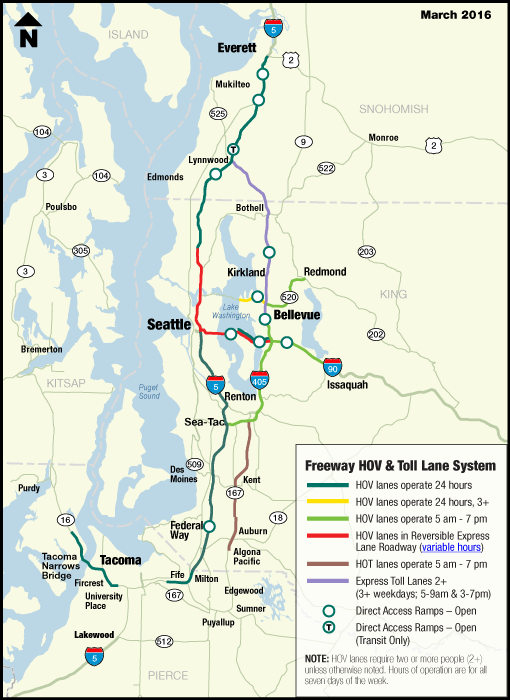November 11, 2016
Realizing the carpool potential in the Puget Sound Region

Elyse O’C. Lewis
Public agencies have been trying to incentivize carpooling (or at least dis-incentivize driving alone) for years, but through pavement markings and toll booths rather than with technology. The implementation of lane restrictions and tolling in the form of High Occupancy Vehicle (HOV), High Occupancy Toll (HOT), and Express Toll lanes serve as different means to the same end. HOV and HOT lanes aim to restrict access (only cars with 2+ people and/or people willing to pay a toll) to decrease congestion and offer faster drive times.
Using lane restrictions such as these is especially useful and prevalent in the Puget Sound Region (PSR) wherein the topography, environmental concerns, and ever-growing population density make the expansion of major roadways financially difficult. To deal with the space issue, the Washington State Department of Transportation (WSDOT) has established a network of HOV, HOT, and Express Toll lanes throughout the PSR (as shown below and further explained here) in an attempt to encourage drivers in the region to carpool.

Lane marking types and locations throughout the PSR intended to encourage carpoolinghttp://www.wsdot.wa.gov/HOV/Map.htm
While this type of infrastructure provides a useful base of incentives/disincentives, carpooling has become less attractive over time. According to a recent Seattle Times article, carpooling for commute trips in the PSR has remained more or less steady since the 1980s despite the fact that the workforce in the area has grown by more than 80%, and while more people have and use public transit options for commute trips today, driving solo to work is up from 63% to 69% in the region. The article posits that the lack of interest in carpooling is primarily the result of flexible work hours for employees which make a fixed carpool less appealing in today’s world. Further, the article cites the UW’s Mark Hallenbeck and the concept that time spent picking up additional passengers must be offset by time saved in HOV, HOT, and Express Toll lanes, but that with increased congestion in suburban neighborhoods and the propensity of people to simply run late, the time saved may not exist or at least not be worth the effort. Ultimately they concluded that ridematching technology recently put forth by Uber and Lyft may have the ability to make carpooling more flexible and therefore more utilized, noting that more than half of all Uber and Lyft rides in New York City and San Francisco are now pooled.
While carpooling through apps such as Uber and Lyft have potential as a viable commute option for higher-income individuals in the central cities, it has its limitations. As the table below shows, this form of carpooling costs from 2x to over 5.5x more than a comparable bus route even for short commutes in the urban center. Further, while these services can connect suburban commuters to the urban center, such trips would rapidly fall into the cost prohibitive category for regular commutes.

Cost per mile for the common commute route of Ballard to SLU within the City of Seattle
In response to the general dislike of structured carpools and in an attempt to utilize the possibilities afforded by the now-commonplace smartphone, King County Metro (KCM) has launched the pilot program TripPool. TripPool utilizes the iCarpool app platform to pair riders with drivers. Beyond this, KCM provides the vehicles, gas, and maintenance for drivers, and guarantees a spot at park and rides, and access to any HOV lanes along the route. The cost of the service is simply $0.26/mile for riders who pay via credits in the iCarpool app, but riders can also link their iCarpool, RideshareOnline.com (another regional ridesharing tool), and ORCA card accounts to decrease costs further. Essentially, KCM is trying to use apps along with tangible (vehicle and parking) incentives to minimize the logistical costs related to carpooling in order to make the time saved in the HOV lane as effortless as possible.
The program launched in The City of Redmond in May of 2016 and looks to expand to the City of Bellevue, Mercer Island, and southeastern King County. In contrast to services such as Uber and Lyft which are inherently more focused on intra-city commutes, this KCM model looks to provide a last mile (and then some) commute option for inter-city commuters. Further, the KCM model is a non-profit, peer-to-peer service which makes it a more accessible commute option from a cost perspective.
While both models will likely prove necessary in a rapidly-growing region, the KCM TripPool program has the potential to serve larger portions of the population both by virtue of its cost structure and as satellite cities (such as Redmond and Belleview) continue to grow.
Recent Comments